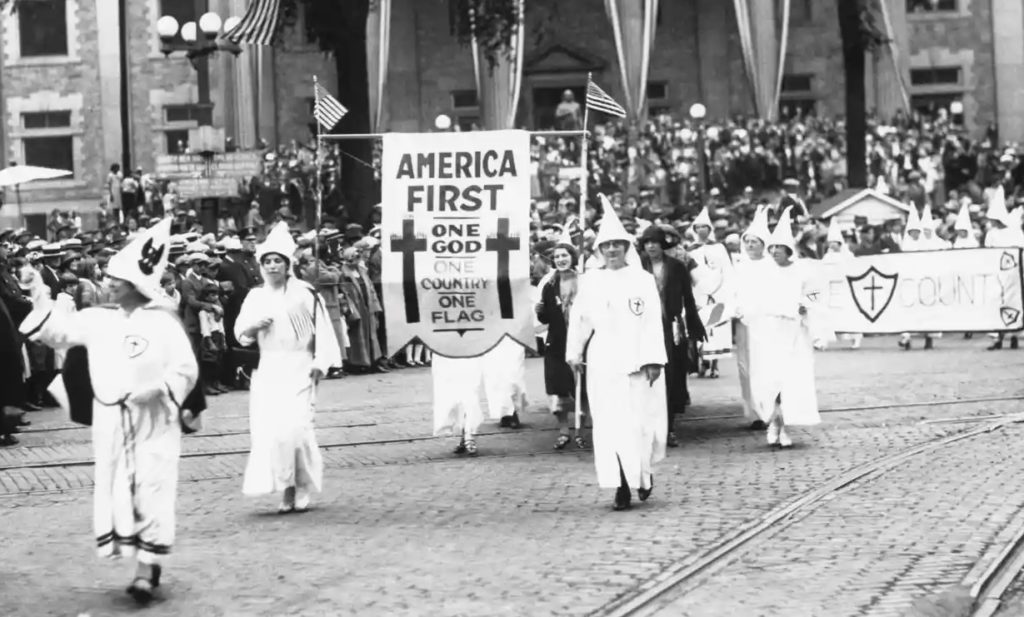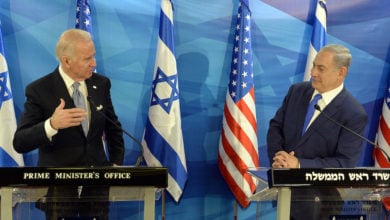Photo: U.S. Congresswoman Marjorie Taylor Greene at the 2021 AmericaFest in Phoenix, Arizona. Credit: Wikimedia Commons.
A new political current is on the rise, realigning the terms of the debate over U.S. foreign policy. A far-right segment once considered fringe within the Republican Party, including some of the most hardline supporters of Donald Trump, have come out in vocal opposition to U.S. involvement in the Ukraine war and are critical of the all-important NATO military alliance. These “America First” isolationists include the likes of Trump himself, Representative Marjorie Taylor Greene and Senator Josh Hawley, among others.
Make no mistake: The war in Ukraine is one driven by military contractors, U.S. financial interests, and above all the overarching goal of U.S. empire to prevent the emergence of any power that can challenge its dominance. NATO is an imperialist military alliance that must be disbanded. We should vociferously oppose the U.S. government’s role in driving this war and sustaining it through the billions of dollars it continues to send in military aid.
But aligning ourselves with these far-right politicians to end this war is a short-sighted strategy. Their opposition to NATO stems from their drive toward further and further austerity, spelling disaster for the working-class domestically. Just like those that came before them, this resurgent brand of America First anti-interventionism is accompanied by the impetus to dismantle public spending and social services, as well as a vicious form of anti-immigrant nationalism. And ending the war in Ukraine is only a concern insofar as it allows them to fully direct all of the U.S. government’s resources toward a military confrontation with China — their top priority.
This is why such isolationism can never displace international working-class solidarity, which we must build as the foundation of the antiwar movement.
Origins of America First isolationism
This type of far-right chauvinism posing as “antiwar” is, in fact, an ugly trend within the ruling class. This current ideological realignment in the Republican Party represents a re-emergence of the America First isolationism that first appeared in the early 20th century, gaining popularity up until World War II and then later marginalized during the onset of the Cold War. This isolationism was replaced by a brand of ultra hardline militarism typified by Ronald Reagan’s “peace through strength” foreign policy — that “peace” in the United States was achievable through the projection of military strength and global military domination — which has been part of the official Republican Party platform in the four decades since.
The phrase “America First” was first coined by Woodrow Wilson while running for re-election in 1916. Wilson’s campaign slogan “He kept us out of war, America First” was a promise that the United States would remain neutral in World War I, though once re-elected, he broke this promise and made the decision to enter the war. Wilson was a Democrat, but this form of nationalism throughout the next few decades developed into Republican orthodoxy, combining anti-intervention foreign policy with high tariffs on imports and nativist anti-immigration sentiment. During the 1920s, the slogan was even adopted by the Ku Klux Klan.
In January 1920, then-U.S. Senator Warren G. Harding, in a speech delivered at the Waldorf Hotel, voiced his opposition to joining the League of Nations:
“But I have a confidence in our America that requires no council of foreign powers to point the way of American duty,” Harding stated. “Call it selfishness of nationality if you will, I think it an inspiration to patriotic devotion — to safeguard America first, to stabilize America first, to prosper America first, to think of America first, to exalt America first, to live for and revere America first.”
Once elected president, Harding signed into law the Emergency Quota Act, a restrictive immigration law which set quotas on those coming from eastern or southern Europe, as well as non-European countries.
“The generally expressed desire of ‘America first’ cannot be criticized,” stated Harding’s successor as president, Calvin Coolidge, in a 1925 speech. “It is a perfectly correct aspiration for our people to cherish. But the problem which we have to solve is how to make America first. It cannot be done by the cultivation of national bigotry, arrogance, or selfishness. … Here again we must apply the rule of toleration.”
Despite these platitudes of tolerance, Coolidge had, just the year before, signed into law the Immigration Act of 1924 — the harshest set of immigration restrictions in U.S. history up until that point. The law placed high barriers of entry into the United States, effectively barring immigrants from Asia and setting quotas for those from eastern and southern Europe. It also created the U.S. Border Patrol as a federal agency. In addition, Coolidge waged war on workers domestically. His program of tax cuts, limited government regulation, and limited welfare and aid only created more social inequality.
A couple of decades later in 1940, the America First Committee was formed as a political group against U.S. entry into WWII, and at its height, boasted over 800,000 members across 450 chapters nationwide. Not believing the United States was vulnerable to attack, members of the committee campaigned against aiding Britain, as they thought doing so would drag the nation into war when it should be building their own defenses.
“I have been forced to the conclusion that we cannot win this war for England regardless of how much assistance we send,” declared American First Committee spokesperson Charles Lindbergh, addressing members of the organization in 1941.
Perhaps unsurprisingly, the AFC was plagued with anti-Semitic and fascist elements. In another 1941 speech, Lindbergh blamed Jews for pushing the United States into a war that was not in its national interest. “Their greatest danger to this country lies in their large ownership and influence in our motion pictures, our press, our radio and our government,” he proclaimed.
And just a couple of years before, in 1939, Lindbergh wrote in a Reader’s Digest column, “We can have peace and security only so long as we band together to preserve that most priceless possession, our inheritance of European blood, only so long as we guard ourselves against attack by foreign armies and dilution by foreign races.”
The AFC was dissolved shortly after Japan attacked Pearl Harbor and the United States officially entered the war. The America First ideology grew increasingly more marginalized within the Republican Party as the Cold War emerged, as the ruling class united around stopping the spread of socialist revolution by military means and proxy wars across the globe.
America First after the Cold War
While nowhere near the political force it once was, remnants of the America First ideology lingered within the fringes of the Republican Party. For instance, Pat Buchanan ran for president on an “America First — and Second, and Third” anti-interventionist platform in 1992 and 1996 seeking the Republican nomination, and again in 2000 as the Reform Party candidate.
In his 1992 presidential announcement speech, Buchanan asserted of social programs for the poor, “Over a quarter century we have poured hundreds of billions of dollars into Great Society programs. Whatever the motives of those who built this mammoth state enterprise, our financial loss has been exceeded only by the social catastrophe it created.”
“High school test scores drop almost every year, as the levels of violent crime reach new heights. Narcotics have ravaged a generation,” he continued, playing on racist and anti-worker tropes, “Our popular culture of books, movies and films is as polluted as Lake Erie once was. The welfare state has bred a generation of children and youth with no fathers, no faith and no dreams — other than the lure of the streets.”
In his 2000 presidential election platform, Buchanan called immigration an “invasion” and warned, “Letting in foreigners was Christian, but killed ancient Rome.”
“Nearly 90% of all immigrants now come from continents and countries whose peoples have never been assimilated fully into any Western country,” the platform continued. “The dividing line on the issue is not liberal vs. conservative, but elites vs. the people.”
Here, we see the same faux populist rhetoric that supposedly appeals to the “white working class” that would be later used by Trump to galvanize his supporters.
Isolationists like Buchanan now set their sights on NATO. While they saw the Cold War as “an exceptional time that called forth exceptional commitments,” in which a temporary alliance like NATO was perhaps necessary, America was overextending its responsibilities with its continued expansion after the Soviet Union had already disbanded.
Buchanan warned in his 1999 book “A Republic, Not an Empire,” “With the expansion of NATO, we have undertaken the defense of Eastern Europe, forever, as well as Central Europe from Norway to Turkey.”
Critical to understanding such isolationism is that historically, subscribers of this ideology oppose U.S. involvement in wars such as WWII, the conflict in Ukraine, and NATO expansion on the basis that they see them as transfers of U.S. wealth to Europe. Europe, in their eyes, should instead be spending its own money for defense.
“The history of NATO has been one of Americans doing the securing and Europeans doing the collecting,” wrote economist Melvyn B. Krauss in 1998. “In the post–World War II period, for example, the Western Europeans constructed the most elaborate welfare states known to man with the resources they would otherwise have had to spend on their own defense had the United States not done the defense spending for them. (The positive side of the coin is that the U.S. welfare state was reduced as a result of U.S. spending on NATO.) [emphasis added]”
America First under Trump
Donald Trump’s insurgent 2016 presidential campaign breathed new life into America First anti-interventionism. Trump’s criticisms of NATO on the campaign trail echoed Buchanan and Krauss’s nearly two decades before.
“[O]ur allies are not paying their fair share, and I’ve been talking about this recently a lot,” declared Trump during a campaign address in Washington, D.C., where he outlined what he himself called his “America First” foreign policy. “Our allies must contribute toward their financial, political, and human costs. But many of them are simply not doing so.”
“In NATO, for instance, only four of 28 other member countries besides America, are spending the minimum required two percent of GDP on defense,” Trump continued. “We have spent trillions of dollars over time on planes, missiles, ships, equipment, building up our military to provide a strong defense for Europe and Asia.”
After the beginning of the Russian special military operation in February 2022, the isolationism of the Trump-aligned Republicans gained full steam.
Just like the America First proponents that came before them, the far right’s opposition to NATO and the Ukraine war is based on the belief that conflicts in Europe are Europe’s own problems to solve. In their view, military alliances such as NATO drain wealth and resources from the American economy to defend Europe.
“I just got back from meeting with the Ukrainian Parliament in Poland, where they demanded F-35s and thought it was an obligation for every American to pay $10 a month to fund their war,” Florida Republican representative Anna Paulina Luna told a New York Times reporter in May.
Echoing the early isolationists’ claims that Europe’s problems are Europe’s alone to solve, those among the far-right like Marjorie Taylor Greene have rebuffed further U.S. military aid to Ukraine, asserting that “Ukraine is not the 51st state.”
In April, Marjorie Taylor Greene planned to launch the America First Caucus, which would have brought together a group of far-right legislators dedicated to “promote Congressional policies that are to the long-term benefit of the American nation.” Its national security platform mirrored standard isolationist policy declaring, “America should not be sacrificing blood and treasure while our so-called allies refuse to pull their weight in contributing to neutralizing threatening actors in the world.”
And the caucus’s immigration platform, which called for the “defense” of America’s border, is only reminiscent of the immigrant quota legislation passed by Harding and Coolidge during the previous century:
America is a nation with a border, and a culture, strengthened by a common respect for uniquely Anglo-Saxon political traditions … America’s legal immigration system should be curtailed to those that can contribute not only economically, but have demonstrated respect for this nation’s culture and rule of law. America’s border must be defended, and illegal immigration must be stopped without exception … An important distinction between post-1965 immigrants and previous waves of settlers is that previous cohorts were more educated, earned higher wages, and did not have an expansive welfare state to fall back on when they could not make it in America and thus did not stay in the country at the expense of the native-born.
Greene ultimately canceled the launch of the caucus after criticisms and blowback from leaders within the Republican Party.
But this was not the first time she waged a war on immigrants. In 2021, Greene introduced the Protect America First Act into the House, which, if it had passed, would have pulled funding from U.S. sanctuary cities; expedited the deportation of undocumented immigrants; further emboldened ICE to detain and deport those who cross the border; eliminated programs like DACA; and put more border patrol officers along the southern border.
The faux populist rhetoric espoused by these American First isolationists is merely political theater. Not only have they brazenly attacked immigrants through these kinds of racist legislation, they have shown time and time again they are committed to eliminating the welfare state, spelling devastation for workers domestically. Despite whatever appeals he made to the working class, Trump over the course of his term significantly slashed the social safety net: his budget cuts opened the door to scale back Medicare, Medicaid, and Social Security, and he moved to kick some 700,000 people off of food stamps — all while cutting taxes for the ultra rich.
From a proxy war in Ukraine to a war on China
Critical to understanding this new resurgent America First ideology is that its proponents’ opposition to the war in Ukraine is driven by the belief that it drains resources from addressing what they consider the real enemy: the Communist Party of China. Indeed, these far-right Republicans want to end the war in Ukraine only to pivot to a war on China — and they have openly disclosed this fact.
“The core problem is that our actions in Ukraine are directly affecting our ability to project force elsewhere,” stated U.S. Senator Josh Hawley in a February speech delivered to the Heritage Foundation. “Specifically, to deter China in the Pacific … For starters, the more U.S. resources we devote to Europe, the fewer we have available to strengthen deterrence in the Pacific.”
The likes of Greene and Hawley see China as an existential threat to western civilization, necessitating quick and decisive action on the part of the United States. Thus, these far-right isolationists are not “antiwar” at all — they oppose war to defend what they see as Europe’s interests, but will go to war to defend the interests of those within their faction of the ruling class.
According to the America First Caucus policy platform, “Not since the fall of the Soviet Union has America faced a civilizational challenge from another state actor quite like the modern Chinese Communist Party (CCP) … [W]e understand that the rise of China means that the United States must be prepared militarily and economically to compete with a peer-competitor.”
And the new Cold War employs similar Red Scare tactics to the old Cold War, such as imagining the communist threat in your backyard.
“I’m sure we’ll soon be voting on yet another supplemental aid package to Ukraine. Meanwhile, China is literally in our backyard now,” Hawley warned ominously, when news first broke of a supposed Chinese “spy base” in Cuba.
It is clear that these far-right legislators only want to end the proxy war in Ukraine to be in better position to attack the United States’ other new Cold War enemy: China.
America First is a war on the working class
America First isolationism is nothing new, nor is it just anti-interventionist doctrine.
This new realignment within the Republican Party is only reflective of the shifting face of U.S. imperialism, as the ruling class tries to contend with the heightening of the capitalism’s contradictions domestically. Then as now, such isolationism is tied to a platform of austerity, historically coupled with the elimination of the welfare state and public services, along with racist anti-immigration policies. Its policies rob workers at home of a social safety net, while shifting the blame to workers across the border and abroad. The far right’s antiwar posturing on Ukraine is a smokescreen, and we shouldn’t be fooled by their rhetoric: America First isolationism is a war on the working class.







